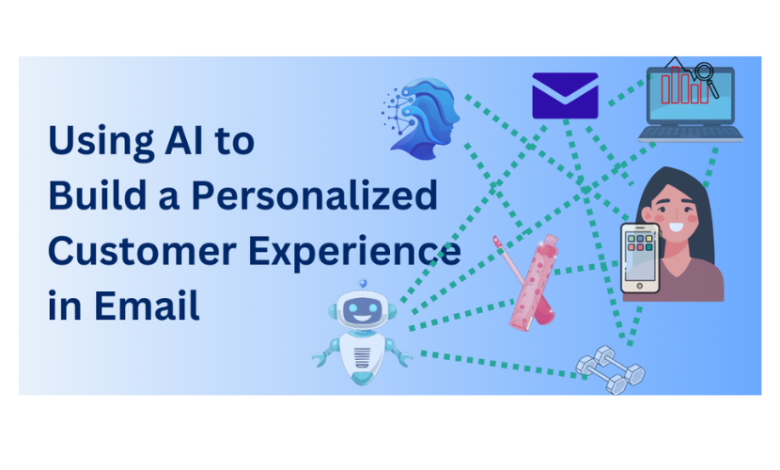
Spotify didn’t just stop after using AI to create a list of the best music pieces of the year. They took it to the next level – in 2023, they created an AI-powered DJ, basically an audio guide. And it’s super-realistic, because it’s based on the personality of Xavier ‘X’ Jernigan, Head of Cultural Partnerships at Spotify, very much a real person.
Jernigan recalls his initial reactions upon being pitched “I’m just like, ‘Wait, what? It’s gonna be me but it’s not me… but it’ll sound like me.” Using Open AI and Sonantic, the voice-AI technology firm Spotify acquired in 2022, the audio-streaming platform was successful in creating the persona. According to Jernigan, it “passed the mama test”, cheerfully explaining how his mother, a regular listener, approved of it.
AI is being put to use in nearly every place possible, so how easy is it to plug it into something as basic as an email? The answer isn’t easy.
Moving to intelligent personalization
The most obvious use of AI in emails would be personalization that would go well beyond “Hi Mike” (salutation) or “Hey Olga, your tee is about to disappear” (subject line). While the mail-merge feature of MS Word has been doing it since a long time, it wasn’t intelligent or automated.
The next use case for using AI in emails is about predictive scheduling. Technology notices that John Doe is most likely to open/read emails at 8AM, Kofi Doe at 1030AM, Jane Doe not until after lunch, and Chang Doe in the evening. Customer data platforms (CDPs) help unify this data from different touchpoints, ensuring AI systems have a complete picture of each user’s journey. Customers now expect emails to reflect what they’ve actually done, browsed, or purchased. So the system personalizes the delivery time, in order to maximize the chances of the email being read.
Real-life example
Amazon applies predictive modeling to identify when you, as the user, are likely to run out of consumables (like vitamins, cleaning supplies, or pet food). You’ll receive email reminders just before you are most likely to place the next order. This approach uses AI to forecast behavior, creating emails that feel timely and helpful rather than an interruption. If you aren’t using a subscription model, this is a great way to boost repeat purchases and slash generic sends.
How AI impacts engagement and retention
We can look at a few studies and articles to understand if AI has led to a positive impact. The immediate goal was personalization, because personalization can lead to engagement, conversion or retention.
AI-driven personalization has delivered significantly better open and click-through rates than traditional, broadly segmented or generic email campaigns. But what does personalization actually do?
A 2021 McKinsey article mentions that personalization has helped businesses scale faster. “Companies that grow faster drive 40 percent more of their revenue from personalization than their slower-growing counterparts.” the report says. It’s important to note that the title of the article hints that getting personalization wrong can be costly as well.
But about using AI to personalize emails?
A June 2025 article by SuperAGI says businesses can see a 10% increase in conversion alone, by using AI to create personalized emails. Open rates grow a great deal bigger – a 45% increase.
These numbers matter. Even small percentage improvements in opens or clicks, when scaled across large lists, can translate into concrete increases in traffic, conversions, and revenue.
Improvements in CLV (Customer Lifetime Value) and Retention
Some of you are likely to say, “Open Rates is a great metric. But what matters is conversion. And retention. And realizing CLV.”
Absolutely. Open rates is a great idea, but it doesn’t beat conversion. And conversion is cool, but not as cool as retention or Customer Lifetime Value.
The McKinsey article that we mentioned earlier has three interesting numbers:
- 76% of the customers are more likely to make a purchase from businesses that use personalization,
- 78% of the customers are more likely to make a repeat purchase from businesses that use personalization, and
- 78% of the customers are more likely to recommend the business/brand to friends, when the brand uses personalization
These numbers suggest that AI personalization doesn’t just lead to one-off wins in email performance, but can shift retention curves meaningfully.
Ethical considerations: Balancing AI against ethics
With AI helping personalization, the question “How much is too much?” grows in importance. It becomes the responsibility of the organization to strike the right balance between what AI can do and what can be unethical. Overstep, and you erode trust quickly, undoing the very gains personalization is meant to deliver. Underuse the technology and you are no better off than when you started out.
Data privacy and customer consent concerns
AI-powered personalization relies heavily on customer data. That includes browsing history, purchase patterns, location signals, and even predictive analytics of future behavior. Collecting and processing such data without clear consent risks violating privacy laws (like GDPR or the EU AI Act) and, more importantly, damaging customer trust.
Marketers should ensure:
- Clear, provable consent: Customers should know what data is collected and how it will be used.
- Minimal data principle: Collect only what’s essential for the personalization goal.
Compliance alignment: Stay updated on regional and sector-specific regulations (e.g., FTC guidelines in the U.S., GDPR in the EU).
If you aren’t careful, collecting information to personalize communication could look like surveillance or downright creepy.
Avoiding personalization that feels “creepy”
Where do you draw the line between relevant and intrusive?
Let’s say you asked for (and received) consent to track a user’s browsing activities – search, heat maps, and stuff. But you worded the consent description in complex legalese. Now if you outright reference a customer’s recent web search in an email subject line it can make people uncomfortable. Similarly, over-personalizing with hyper-specific demographic or behavioral insights can create the sense that a brand is following the consumer like a private eye in a paperback who’s following a suspect.
To prevent this:
- Use contextual personalization: Remind them of items left in a cart) rather than digging into unrelated behaviors.
- Test customer reactions: Run experiments in order to learn what boosts engagement versus what leads to unsubscribes.
- Decide what you want: Just because a blog or a consultant suggests you collect some piece of information doesn’t mean you should actually do so. Fully understand what you’ll do with the data, before collecting that data.
- Switch roles: Always ask, “Would this message feel helpful to me if I received it?”
The key is to prioritize relevance without being intrusive.
Transparency and explainability in AI models
AI systems make more decisions in real time. Let’s say you’re trying to understand which product to recommend or which customer segment to prioritize. But how do you explain it?
- Internal: Marketing teams should understand why the AI system is recommending a specific action, ensuring that decisions align with brand values.
- External: Inform subscribers, in clear language, when content is AI-generated or AI-assisted, and provide easy opt-outs. Mention how you collect and process information.
- Bias monitoring: AI models can inadvertently reinforce bias if trained on unbalanced data. Regular audits help prevent this.
Transparent communication not only meets compliance requirements but also shows respect for the customer, strengthening long-term trust.
Summing up
Two years back, we invited marketers to share inputs on using ChatGPT for email marketing. And while most felt the platform was great in many ways, they agreed that getting the tone right and personalizing messages did require some work. Effectively, they were saying that technology will crunch lots of data, but you’ll need to edit, improve, and make decisions.
Because of the wide availability of AI and analytics tools, most marketers have access to nearly similar resources. That means the marketer who is compliant, empathizes, balances tech and privacy, and puts those resources to the best use will win.

